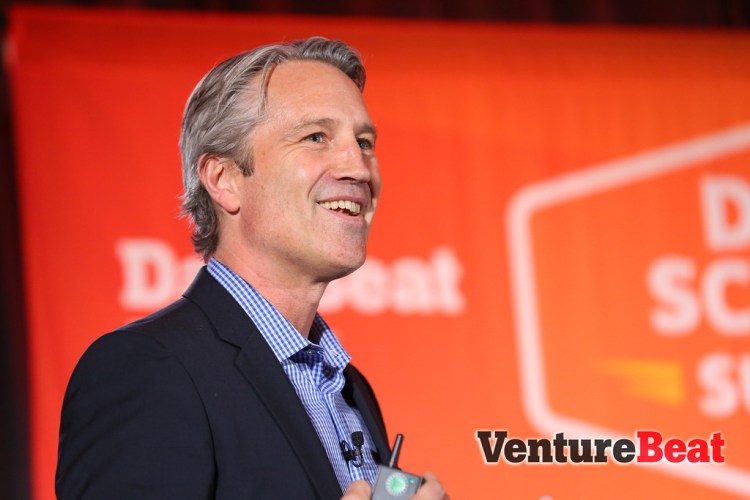REDWOOD CITY, Calif. — Big data is thrown around a lot as jargon, but some powerful case studies out there show how data is reshaping industries.
Today at VentureBeat’s DataBeat/Data Summit, executives from six companies from health care, fashion, education, media, transportation, and business shared examples of how they are using data to create opportunities that never existed before — and create a more personalized experience for their customers.
Icahn School of Medicine at Mt. Sinai Health Care Foundation
Joel Dudley is the director of biomedical informatics at Mt. Sinai, which is the largest private health care system in New York State. Its 6,000 physicians conduct over 3.4 million patient visits a year.
Mt. Sinai’s CEO recently made a $100 million commitment to integrate data and genomics into every aspect of its organization to create more precise, positive patient outcomes. It brought in 100 informaticians and data scientists help doctors and nurses make data-driven decisions.
“No one is more aggressive or committed to changing health care into a data-driven, science-driven practice,” Dudley said onstage. “We need to be more predictive and understand more precisely where the patients fit into our data universe, what the optimal treatments are for them to achieve the best outcomes, and how to keep them healthy the longest.”
Dudley talked about the problem of “data exhaust” in health care — a huge amount of data comes in, but it’s never stored or looked at and “goes up into the air.” Mt. Sinai aims to use this data to create a broader view of individual patients as well as to create an overarching view of its entire population to identify trends and patterns.
Genomics plays a big part in this. Mt. Sinai has collected genomic data for 25,000 patients and combines this with electronic medical record information (EMR) and lab results to create what Dudley described as a “new taxonomy of disease.”
He gave the example of Type 2 Diabetes. By creating a map of diabetes cases, along with other genetic markers, physicians can get a more nuanced picture of their patient and prescribe treatment accordingly.
Stylitics
Stylitics gathers more data than ever before on women’s closets. Cofounder and CEO Rohan Deuskar said that despite decades of research and millions of dollars, brands, retailers, and publishers still don’t have access to the answers to three key questions: where women shop, what they buy, and how they wear it.
“This is an impossible dataset, but it is really valuable for the fashion industry,” he said. “This bizarre situation emerged where retailers base marketing, recommendations, and offers based on 5 percent of the information about you, but they miss the other 95 percent of your purchasing behavior. Getting this data was the challenge we set out to solve.”
Deuskar described this type of information as “best friend data” — a complex and intimate source of information that is only available from consumers themselves.
Stylistics aims to acquire this information through its “digital closet platform.”
Women enter the clothing they wear into Stylitics, with information about brand, color, style, and price. In exchange for this raw data, Stylitics gives it back to users in a more organized, accessible form. The application makes all your clothes sortable and searchable (like in Cher’s closet in Clueless), offers a smart style assistant, and makes personalized shopping recommendations.
However, the real impact is on the retail side. Merchants can use Stylitics’ database to access information about specific population segments and demographics and find out what is in the closets of the consumers they are trying to reach.
“This is the largest stream of outfit and purchase data out there, and this is shifting how brands and retailers think about consumer insights,” Deuskar said. “If they want to know what shades of pink teenage girls are likely to wear for athletic attire, they can do it without spending the time or money on traditional surveys or market research. This is turning the fat, long tail of the fashion industry on its head.”
Apollo Education Group
Data is the only way the University of Phoenix can give every one of its 300,000 students the attention they need.
The University of Phoenix was one of the first online universities and is currently one of the largest educational providers in the world. It has served 2.5 million students over the past 20 year and at its peak saw 500,000 students enrolled at one time. It currently has 36,000 staff members.
Rob Wrubel is the chief innovation officer for University of Phoenix parent company Apollo Education Group. He said the organization relies on data to figure out the when, where, and how of engaging with its students.
“The University of Phoenix is aimed at working adults, many who have been out of the school system for many years and carry significant challenges,” Wrubel said. “They are juggling time, lives, and finances, and we are under significant pressure to drive outcomes for our students, improve retention, engage in academic success, and keep our costs down.”
The university assigns multiple counselors and support staff members to every student, but it’s impossible to regularly check in with every one about their academics and finances.
Using data, the University of Phoenix is able to realize which students need interventions when and for what and allocate its resources accordingly. It is also working on adaptive learning technology to tailor the classes for each students’ needs.
“Our content and learning variability is enormous,” Wrubel said. “We have 1,700 different courses, tens of thousands of pieces of content, and multiple types of learners coming from very different backgrounds from very different life circumstances. Data provides a low-cost, high-return way to preserve our students and pull out insights about complex behaviors.”

